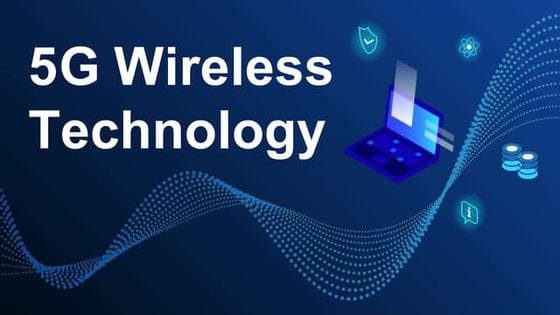In-depth Exploration into the Era of Fifth Generation (5G) Wireless Network Technology is the sign of technological revolution that combined with the demands and requirements for very fast speed communication and applications that are based on Internet of Things (IoT). IoT devices and mobile phone technology support 5G technology to invent with different features like smart city, smart building and many more that will require an antenna with 5th generation technology with low latency, minimum path loss and stable pattern of radiation. This paper provides an in-depth study of the different features of all wireless generations along with their main features along with 5G technology.
Introduction
The whole world has witnessed many developments in the field of communication. Over the years, the drastic development of wireless services and technologies has contributed a lot in creating our economic system and society. The world has moved towards digitized format, from services that are using only voice applications, from second generation to fourth generation to wireless broadband connectivity and beyond. New development in technology not only supports but also expands the boundaries of easy to use policies authorizing multiple users and uses. This is true in view of fifth generation technologies which allow larger bands of spectrum for quality purposes than many previous wireless generations.
Fifth generation wireless network technology is the next major step in mobile phone telecommunication standards beyond the current fourth generation/IMT advanced standards. Along with many improvements, 5G planning is also expected to provide much faster internet connectivity speeds than the current 4G. The fifth generation smartphone mixed media network of the internet can be communicated completely wirelessly without any major obstacles which will enable a complete real world wirelessly known as the World Wide Wireless Web (www). It is based on 4G technologies.
Evolution of Generations from 0th to 5th Generation
0G Wireless Systems:
In the late 1940s, the first radio telephone service came into the picture. It was designed to communicate between callers in four wheels to the land-line connected telephone network. During the year 1960, new technology called Improved Mobile Telephone Service (IMTS) was introduced, a system introduced by the Bell System that brought some changes like direct dialing and a larger bandwidth. In the late 1960s and early 1970s, IMTS was the main technology on which the earlier analog systems were based.
1G Wireless Systems:
These systems use USESNETWORKS analog signals. A very high frequency which is near about 150 MHz was used for voice modulation. First generation analog cell phones which have speed limited to 2.4 kbps allow callers to initiate voice calls in a country. The main features of the 1G standard are: * Advanced Mobile Phone System referred to as AMPS * Nordic Mobile Telephone referred to as NMT.
2G Wireless Systems:
These wireless systems are commercially launched on the standards of GSM (1991). 30 to 200 kHz is the bandwidth used by 2G wireless systems. 2G networks allow for much higher penetration intensity. E.g. GPRS, CDMA . It also provides the facility of SMS (Short Message Service).
3G Wireless Systems:
This type of wireless system uses the technology of Code Division Multiple Access and Time Division Multiple Access. In the field 3G came into use in 2005 (WCDMA, WLAN and BLUETOTH) in computer networking and mobile devices (cell phones and GPS). In terms of spectral efficiency, 3G technology is far superior to 2G technology. The transmission speed ranges from 125 kbps to 2 Mbps. Packet switching is the main technology through which the data is sent. The main feature of 3G wireless systems is much higher clarity in voice calls and access to global roaming.
4G Wireless Systems:
This type of wireless system should be able to provide a smooth roaming around the world with 4G mobile phones. 4G provides both cellular and multimedia services everywhere in the world. Nowadays with 4G, the mobile TV provider redirects or delivers the TV channel facility directly and completely to the customer’s phone where it can be watched. One of the main features of 4G technology is video on demand on the customer’s phone. The video conferencing facility allows customers to watch and communicate with each other. Using telecommunication, one can also have medical advice. The main features like mobile ultra-broadband (gigabit speed) access as well as good multi-carrier transmission are also available in 4G wireless systems. 4G provides some similar features as the third generation along with some important applications like multi-media newspapers, enables users to watch T.V programs with good vision and clarity and sends data with much higher speed than other previous generations.
5G Wireless System
Very many important telecommunication giant consortiums are making progress all over the world to create universal values in the fifth generation wireless network technology. Despite having lots of these standards, the experts in this field anticipate the fourth generation and third generation to be more compatible with each other yet. With the increase in the demand of users and callers rapidly, the fourth generation wireless technology can be easily replaced with the fifth generation technology which is named as Beam Division Multiple Access i.e. BDMA and or Filter Bank Multi Carrier Access. By considering the case of the base station which is communicating with the mobile stations, the main concept behind the BDMA technology is. Each and every mobile station is given an orthogonal beam and by using the beam division multiple access technique one can divide that antenna beam according to the locations of the mobile stations for multiple access to the mobile stations, which will certainly enhance the merit of the 5G system and thus it is seen as the important and main process of BDMA communication. Some of the reasons for changing the direction of 5G wireless systems are based on the current scenarios. The obstacles that are not seen in 4G technology can be completely dealt with by 5G cellular networks. These are 1: High capacity 2: Large data rate 3: Low cost 4: Consistent quality 5: End to end latency has been reduced, 6: Connectivity to a large number of devices,.
Main features of 5g
• 5G wireless technology offers increased resolution for the intense mobile phones on a daily basis and gives better connectivity for the user and on the internet. • Earlier billing limits are provided by 5G technology that is why this technology will be more successful in the modern era. • 5G technology provides mobile phone users, mobile records are easily available for better printing tasks. • 5G wireless technology allows huge amounts of data to be spread in gigabits. • More accurate and reliable results are obtained by the information that is provided by the 5G technology from data transfer. • Applying the technology named as remote control can get easy and comfortable 5G access in a short time. • Virtual and SUCTICLESSELS NETWORKS is also supported by 5G technology. • 5G wireless technology provides a better internat connectivity across the world. • The wireless technology of 5G network is authentic and high speed.
5G Merits and Demerits
1. Merits of 5G Technology
There are many types of work of 5G technology as listed below. • 5G wireless network technology has the ability to collect all wireless networks on a single platform. • 5G technology is highly efficient compared to other equivalent technologies. • 5G wireless network will make it easier to speed up subscriber supervision methods. • This technology will offer a huge broadcast data in units of Gigabit that will help 60,000 plus connections. • Compatible with earlier wireless generations. • 5G network is technically highly sound to support heterogeneous resources (including private networks). • It is possible to offer continuous, seamless, and seamless connectivity across the globe. • 5G technology supports artificial intelligence applications very well.
2. 5G Demerits
Although, 5G wireless network technology is explored, its concepts are to solve the major difficulties of the existing radio frequency based transmission and cell phone world, yet due to some security reasons and the need for technological enhancement in the majority of geographical areas, it is. Underlying Demerits • Research on the feasibility of 5G technology is currently ongoing. • Due to inefficient technical network support around the world, the internet accessing speed of 5Gwireless network technology is still difficult to achieve in the near future. • A large number of devices used earlier will be incapable of 5G technology, therefore, each of them will need to be exchanged with newer versions. • A huge amount of investment is required to develop the infrastructure needs. • 5G wireless network technology needs to address issues related to security and data privacy.
Read Also:
- Wireless Technology In Networks
- Overview Of Wi-Fi Technology
- Wi-Fi And Hotspots: Emerging WLAN Technology In Indian Context
- Negative Impacts Of Science And Technology
- Benefits Of Science And Technology








Leave a Reply